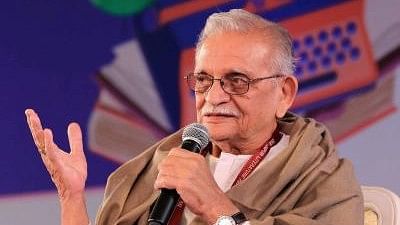
Gulzar
Credit: PTI Photo
New Delhi: Indian cinema has not rid itself of the trappings of early talkies era with films continuing to repeat the 'same old clichés' of excessive dialogue, songs, and fights, said Urdu poet and lyricist Gulzar.
While delivering the 'Samvatsar lecture' at the 39th edition of Sahitya Akademi's Sahityotsav on Wednesday, the Jnanpith awardee said that 'sounds and words may have changed but the essence of the narrative has remained the same'.
'Unfortunately, Indian cinema has still not rid itself of the trappings of the early talkies era. As in Alam Ara or Hunterwali, we are still repeating the same old clichés of excessive dialogue, songs, fights, chases and whatnot,' the 'Maachis' director said.
According to Gulzar, the visuals have advanced with 'the galloping advance in technology', and special effects, the green screen and sound effects are here to stay.
'Let's just hope the newfangled images of Artificial Intelligence don't lead to any semblance of deterioration,' Gulzar said.
The poet-lyricist was talking about writer Mohanlal Gopaldas Dave, who would submit a script every month to respond to an 'unprecedented demand of writers' in film companies in the early decades of Indian cinema.
Dave, a jeweller by profession, worked with Kohinoor Film Company in the 1930s and 1940s.
'It seems, promotional material used to arrive for Hollywood films before they were released in India. He had the knack for Indianizing the plot in a flamboyant style,' the 89-year-old recalled.
'To a major extent, aren't we doing the same today?' he asked.
The celebrated poet started his career as a songwriter in the 1960s in films, including “Kabuliwala”, “Bandini”, “Aashirwad” and “Khamoshi”. Gulzar has also written dialogues and scripts for films in his career spanning seven decades.
Gulzar has also directed award-winning films including “Koshish”, “Parichay”, “Aandhi”, “Angoor”, and “Hu Tu Tu”.
The Samvatsar lecture was on the topic of 'Cinema and Literature'.
The Padma Bhushan awardee talked about the two creative streams, how they have influenced and interacted with each other since the advent of cinema.
Gulzar noted that since the beginning of Indian cinema, the industry has adapted literary works for the screen, including Dadasaheb Phalke's 'Raja Harishchandra', 'Satyavan Savitri' and 'Lanka Dahan'.
'Suffice it to say, considerable dramatic changes and improvisations were made to the original texts. This was to make them more engaging and palatable for the audience. The authenticity of the text, even the holiest of scriptures, ended from that juncture,' he pointed out.
Giving the example of Aparna Sen's '36 Chowringhee Lane', Neeraj Pandey's 'A Wednesday', Nandita Das's 'Firaaq', and Rakeysh Omprakash Mehra's 'Mere Pyaare Prime Minister', Gulzar noted the emergence of 'author-based cinema which is not adapted from any book and it rather an extension of literature”.
'New cinema, at times, writes of one's experience straight out of life and thus creates its own literature in its own language of images,' he said.
Gulzar, who is known for his literary works such as “Raat Pashminey Ki”, “Raavi Paar”, and “Dhuan”, also warned about the trend of making biopics and said that it is “more than welcome but with a statutory warning: the stories should not be distorted in the slightest degree”.
Gulzar concluded the lecture by quoting one of his favourite poets Rabindranath Tagore.
“Around 1929, he (Tagore) had stated, 'Cinema will not become an art till it depends on the use of words and language.' To that may I add, 'And produces its own literature in its own distinctive form of images, instead of leaning against already said and written literature,” he said.
“The maker has to be the author of the film - what we can call an Author's Cinema”.